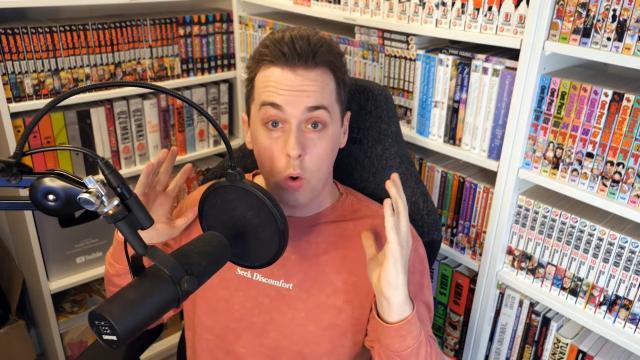In a new video, Mark Fitzpatrick of the anime YouTube channel Totally Not Mark revealed he not only won a battle in his copyright strike war with Toei Animation but also influenced YouTube to create a new copyright rule for content creators.
The new YouTube rule allows for flexibility among international copyright laws where a video may be taken down in one country but left up in another, freeing creators from worrying about outright bans or takedowns of videos. In practice, this means videos are more likely to remain up in countries like the U.S. with stronger fair use allowances.
“It’s certainly reassuring,” Fitzpatrick told Kotaku via email, “But with fair use so ill-respected in so many territories, and YouTube creators with no control over where their content will be shared once they upload there’s certainly a long way to go.”
The situation began this past December, when Toei issued more than 150 copyright claims against Fitzpatrick’s lengthy anime and manga reviews. At the time, Fitzpatrick thanked his fans for their support in a video and announced he would be “stepping away from the situation.”
Read More: YouTuber Hit With 150 Copyright Claims For Reviews Featuring Anime Footage
But shortly after, as Fitzpatrick revealed in a new video providing an update on the legal saga, someone “high up at YouTube’’ who wished to remain anonymous, reached out to him via Discord. Fitzpatrick said the contact not only apologised for his situation not being addressed sooner, but divulged a prior conflict between YouTube and Toei regarding his videos fair use status.
“I’m not going to lie, hearing a human voice that felt both sincerely eager to help and understanding of this impossible situation felt like a weight lifted off my shoulders,” Fitzpatrick said.
Fitzpatrick only first learned of the copyright issue in December 2020 after Toei marked 150 of his videos with copyright strike violations. But that was only the tip of the iceberg. According to Fitzpatrick’s YouTube contact, the animation company then contacted YouTube directly upping those 150 strikes to full takedown notices before emailing Fitzpatrick.
“These are requests to YouTube not to block my content but to delete [the videos] off of my channel…[which] likely would result in the termination of my account,” he said. “And that’s bad.”
According to Fitzpatrick, YouTube decided not to honour Toei’s removal request because that would violate the platform’s fair use copyright policy. Instead, YouTube asked Toei to provide further justification for his channel receiving the takedown notices.
But rather than providing YouTube with evidence, Fitzpatrick says Toei used the website’s automated reporting tools to manually claim and block more than 150 of his videos.
The following week, a game of phone tag ensued between Toei, the Japanese YouTube team, the American YouTube team, Fitzpatrick’s YouTube contact, and himself to reach “some sort of understanding” regarding his copyright situation. Toei ended up providing a new list of 86 videos of the original 150 or so that the company deemed should not remain on YouTube, a move Fitzpatrick described as “baffling” and “inconsistent.” Toei, he concludes, has no idea of the meaning of fair use or the rules the company wants creators to abide by.
“Contained in this list was frankly the most arbitrary assortment of videos that I had ever seen,” he said. “It honestly appeared as if someone chose videos at random as if chucking darts at a dart board.”
Although Fitzpatrick regained control of his videos, he wasn’t out of the woods yet. If Toei filed a lawsuit against him in Japan with its “less robust” interpretation of “fair use,” it’s likely he could lose. Which is where YouTube’s new legal innovation comes in.
YouTube’s new copyright rule allows owners like Toei to have videos removed from, say, Japan’s YouTube site, but said videos will remain up in other territories as long as they fall under the country’s fair use policies. To have videos removed from places with more allowances for fair use, companies would have to argue their cases following the copyright laws of those territories.
Toward the end of his video update, Fitzpatrick laments that Toei’s hostile actions leave a lot of collaborative opportunities on the table without “proper consideration.”
“Similarly to how video games have embraced the online sphere, I sincerely believe that a collaborative or symbiotic relationship between online creators and copyright owners is not only more than possible but would likely work extremely well for both sides if they are open to it,” Fitzpatrick said.
This article has been updated since it was first published, following Fitzpatrick providing comment regarding the status of his copyright battle with Toei Animation and how YouTube’s new fair will impact smaller content creators.
